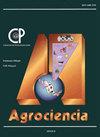树莓树冠瘿中的原生细菌可降低农杆菌的严重程度
IF 0.5
4区 农林科学
Q4 AGRICULTURE, MULTIDISCIPLINARY
引用次数: 0
摘要
由根癌农杆菌引起的冠瘿中的原生细菌群可能含有对该病原体的生物防治感兴趣的细菌。本研究探讨了树莓(Rubus ideaus)树冠瘿的天然细菌种群密度,并评价了它们在体内和体外对瘤胃杆菌的拮抗作用。从6份胆汁样品中分离到形态与瘤胃杆菌相似的细菌,并通过virD2基因测序对其进行鉴定。在营养琼脂和R2A培养基上直接平板计数计算细菌种群密度。通过在营养琼脂培养基上的双重对抗,以及在温室条件下在番茄根部接种1.5 × 108 UFC mL-1,评估了UFC对最常见的葡萄球菌的体外拮抗效率指数。经直接测序和生物多样性鉴定,该菌株在覆盆子瘿中鉴定为A. tummefaciens biovar 1。胆囊内的原生细菌种群密度不稳定,多样性有限。通过16S rRNA基因部分扩增,鉴定出频率最高的菌株有13株,分别为假单胞菌属(61.5%)、芽孢杆菌属(15.3%)、Alcaligenes属(15.3%)和Delftia属(7.6%)。其中,粪碱性芽孢杆菌(Alcaligenes faecalis)对瘤胃杆菌的体外拮抗指数最高(p≤0.05),其次为Delftia sp.和香茅假单胞菌(Pseudomonas citronellolis)。在番茄植株体内接种这些抗农杆菌的拮抗剂并不能预防感染;粪藻显著降低了植物茎肿瘤的严重程度(p≤0.05)。粪芽孢杆菌是体外和体内抗肿瘤芽孢杆菌最有效的拮抗剂。本文章由计算机程序翻译,如有差异,请以英文原文为准。
NATIVE BACTERIA IN RASPBERRY CROWN GALL REDUCE THE SEVERITY OF Agrobacterium tumefaciens
Native bacterial populations in crown galls caused by Agrobacterium tumefaciens may harbour bacteria of interest for biocontrol of this pathogen. In this study, we explored the density of native bacterial populations in crown galls of raspberry (Rubus ideaus) and evaluated their in vitro and in vivo antagonism against A. tumefaciens. Bacteria morphologically similar to A. tumefaciens were isolated from six gall samples and identified by virD2 gene sequencing. Bacterial population density was calculated by direct plate count on nutrient agar and R2A media. The in vitro antagonism efficiency index against A. tumefaciens of the most frequent bacteria was evaluated by dual confrontation on nutrient agar medium, and in vivo by inoculation of 1.5 x 108 UFC mL-1 in the root of tomato (Solanum lycopersiucm) plants under greenhouse conditions. By direct sequencing and biovar characterization, it was identified as A. tumefaciens biovar 1 in raspberry galls. Native bacterial populations in galls have variable density and their diversity is limited. By partial amplification of the 16S rRNA gene, 13 strains were identified with the highest frequency in the genera Pseudomonas (61.5 %), Bacillus (15.3 %), Alcaligenes (15.3 %) and Delftia (7.6 %). Among these, Alcaligenes faecalis showed the highest in vitro antagonism index (p ≤ 0.05) against A. tumefaciens, followed by Delftia sp. and Pseudomonas citronellolis. In vivo inoculation of tomato plants with these antagonists against Agrobacterium tumefaciens did not prevent infection; however, Alcaligenes faecalis significantly reduced (p ≤ 0.05) the severity of plant stem tumours. A. faecalis is the most efficient antagonist in vitro and in vivo against A. tumefaciens.
求助全文
通过发布文献求助,成功后即可免费获取论文全文。
去求助
来源期刊

Agrociencia
农林科学-农业综合
CiteScore
0.50
自引率
33.30%
发文量
51
审稿时长
18-36 weeks
期刊介绍:
AGROCIENCIA is a scientific journal created and sponsored by the Colegio de Postgraduados. Its main objective is the publication and diffusion of agricultural, animal and forestry sciences research results from mexican and foreign scientists. All contributions are peer reviewed. Starting in the year 2000, AGROCIENCIA became a bimonthly and fully bilingual journal (Spanish and English versions in the same issue). Since 2007 appears every month and a half (eight issues per year). In addition to the printed issues, the full content is available in electronic format.
 求助内容:
求助内容: 应助结果提醒方式:
应助结果提醒方式:


